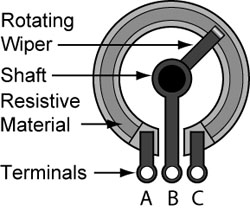Wire Wound Potentiometer Reliability
Potentiometers have been used in electronic circuitry since the early 1900’s. The mass production of valve radio’s in the 1920’s lead to a demand for reliable, cost effective variable resistors for applications such as tone controls and volume controls. Carbon potentiometers were often used as the resistive material(and still are) for low wattage applications. The potentiometer ‘wiper’ – the moving ‘arm’ that connects to one of the potentiometers terminal was often the cause of unreliable operation in early manufacturing operations of potentiometers. The wiper must make an effective and highly reliable contact with the resistance element during operation of the potentiometer to avoid intermittent operation and the generation of ‘electrical noise’, which can interfere with the operation of the accompanying circuitry. In the the case of a wire wound potentiometer the resistance element is a ‘wound’ element, meaning that wire is wound onto a flexible former that is mounted into the body of the potentiometer, onto which the wiper arm sits and rotates and the shaft is turned.
Improving Potentiometer Reliability
Double Contact Wiper Arm
To ensure maximum reliability and long term, trouble free operation of the potentiometer, the wiper ‘arm’ can be made to have 2 contacts that ensure the integrity of electrical connectivity between the wiper and resistance element.
Resistance Element Selection
The constituent components and the winding and construction of the resistance element are a key factor in creating high reliability in a wire wound potentiometer. The AW 3 watt rated wire wound potentiometer uses high grade resistance wire that has been tested in many demanding applications for over 30 years.

